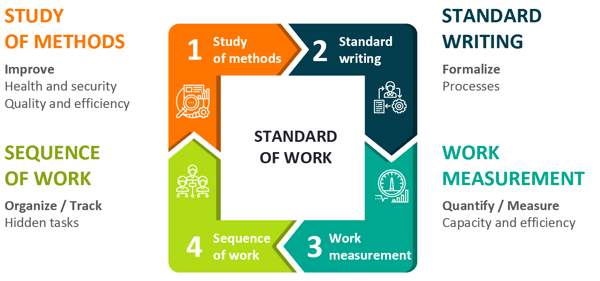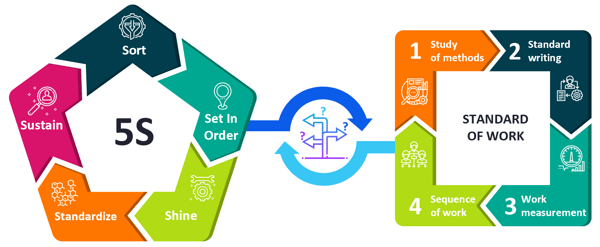5S Methodology or Standard Work, What Should we Start With?
Article updated December 2022
5S methodology or standard work, which should come first? We should start by looking at what those two powerful Lean Management approaches consist in. It will allow us to get a better understanding of what to do first.
5S, understanding the methodology
The 5S methodology consists in organizing a work zone to make it as productive as possible.

A work zone can be any of the following: a work cell, an office, or even a computer directory.
It can be implemented in 5 steps, each of which is necessary to obtain an ergonomic and productive work organization that will allow achieving the best quality possible.
Sort
Determine what items should remain in the workplace. This stage consists in sorting what is useful from what is not, regardless of the number of times it is actually being used.
Set in Order
Now knowing what will remain in the workstation, everything should be organized in an ergonomic manner by positioning each item. We seek to have a place for everything and everything in its place. In this stage, the notion of workstation ergonomics is highly important. It includes identifying storage methods (taking into account heights if needed) as well as storage positioning (in relation to the number of times it’s being used). It is often necessary to establish colour coding for a workstation (identifying storage areas, tools, etc.) to make visual management easier.
Shine
This step is crucial to engage employees. A 5S effort includes cleaning up and setting back to its original state the entire work area (painting walls and machines, get new equipment, etc.). Mobilization often result from the pride employees feel when working in a clean, organized place that corresponds to their needs. Consequently, it will be much easier to identify a gap or an equipment failure or malfunction, a leakage, for example. Thus the need to set up a maintenance routine (daily, weekly, monthly) to sustain the level of cleanliness attained during this stage.
Standardize
Once the decision to set in order each item within a workstation is made, the next logical step will consist in implementing it in a clean environment. This step allows keeping in place the newly implemented structure by using decided upon colour codes and storage set ups. At this stage, it is important to take a photograph of the set standard to refer to on a daily basis.
Sustain
This last step is the very core of the 5S methodology. It consists in defining daily compliance mechanisms validating the entire workstation is in compliance and under control. Multilevel audits can be set in order to show the importance of complying with the 5S methodology and to continuously identify improvement opportunities.
It is important to understand that a workstation can be submitted to a 5S project more than once. As a matter of fact, improving a workstation can be achieved in several phases, as improvement is a continuous affair.
Standard Work
The standard work approach consists in organizing tasks to achieve stability and consistency in daily operations. This will allow identifying a process’s true capability.

Any process can be standardized, but not all steps of a process need to be.
Defining standard work can be completed in 4 key stages which will result in a reliable standardization that will be complied with by the entire personnel.
Method study
This is achieved by observing work practices to capture all the necessary details toward the understanding and explaining of the work being accomplished at a specific workstation. To get sufficient information, observations can be carried out in phases or by videotaping employees while performing their work. Improvements in terms of ergonomics, workstation organization, and work quality are noted on a regular basis through discussions with stakeholders.
Writing Standard Work
Developing standard work consists in defining each task that need to be regulated by safety, quality, technique, and even by written elements. Through these observations, it is possible to write clear and precise instructions. It then becomes necessary that the established visual standard be validated by the entire team to confirm that only one standard applies to all the resources involved in the standardized position.
That step is crucial in a change management setting. Then, we aim at reaching consensus on complying with standard work
Measuring Work
Standard work becomes significant when setting a standard time. At this stage, the standard work that was previously validated, is being thoroughly measured. Several sets of measures can be carried out to capture natural variance, for example, the difference in pace between employees. It becomes important to only measure items defined in standard work and exclude any wastes that could interfere with time study. This part of standardization can sometimes be seen as intimidating and controlling because of working times being formalized. However, it is important to keep in mind that the objective of measuring working times is to define the capability of a workstation.
Work Sequencing
Standard time can be considered as a sequential flow (one task at a time) or as simultaneous flow (several tasks at a time). Indeed, it is sometimes possible to accomplish several tasks at the same time. This is what we call working in masked time. It consists in defining the most effective sequence to keep resources busy (both human and material). Work sequencing will then allow establishing a product or service’s cycle time. This also allows to set up means to monitor standard work. It is then possible to set up audits at given intervals to confirm validated standard work applicability.
Just like the 5S methodology, standardization can, and must, be repeated on a regular basis. Indeed, product and technology changes that could arise would entail tasks and standard time updates. Thus, the standardization of a workstation could be repeated on a yearly basis if necessary.
Sequence of Implementation
As you can see, when considering their respective definition, these two highly operational Lean management tools satisfy complementary needs for improvement.

Answering by saying you need to first and foremost conduct a 5S project, would be neglecting the actual improvement goals of a specific work area. On the other hand, prioritizing the standardization of work processes within a chaotic environment, would certainly not allow for tangible stability and productivity gains.
Any improvement effort must start by analyzing the needs or by defining a problem. Thus, the decision to complete a 5S must be made after identifying wastes such as excess handling or unnecessary or non-ergonomic movements. In the case of a work standardization effort, concluding to an important variance in cycle time or a fluctuating number of manufacturing defects could indicate the presence of issues needing to be resolved.
Combining 5S to a work standardization effort can prove to be beneficial considering the gains resulting from each of those tools. In such a context, the planning and organizing of the effort is a key element to the success of the implementation process.
As a rule of thumb, I tend to favour standardizing the work before making any physical change to the workplace. Standardizing allows laying a measurable baseline, thus establishing a performance improvement challenge.
There is no doubt that in some cases the first standardization effort will not remain the only one being made. After completing a 5S, it is most possible that updating the work organization becomes necessary, or that standard times are no longer relevant.
This small steps method, requiring several iterations, has for advantage to keep employees on their toes about identifying wastes. This way, several improvement ideas get to be considered, and the results are all the more significant.
To sum it up, both 5S and standard work methodologies allow stable performance in a workplace. The two methods need to be considered as being complementary, regardless of the order in which they are implemented. Best practice is to repeat the improvement efforts on a regular basis to maintain the motivation to make changes and to put the emphasis on problem solving on a daily basis. If you are still wondering where to start, plan both efforts within the same workplace at a month’s interval, this will ensure its success.
For additional details on a more condensed approach to 5S implementation, combining standardization and optimization, we invite you to consult this article.





